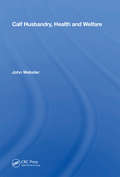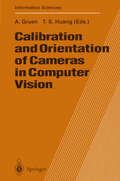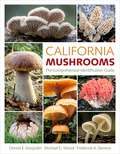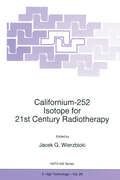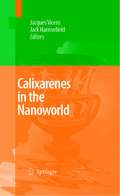- Table View
- List View
The Calculus Wars: Newton, Leibniz, and the Greatest Mathematical Clash of All Time
by Jason Socrates BardiThis vibrant and gripping history ultimately exposes how these twin mathematical giants (Newton, Leibniz) were proud, brilliant, at times mad, and in the end completely human.
Calculus Without Derivatives (Graduate Texts in Mathematics #266)
by Jean-Paul PenotCalculus Without Derivatives expounds the foundations and recent advances in nonsmooth analysis, a powerful compound of mathematical tools that obviates the usual smoothness assumptions. This textbook also provides significant tools and methods towards applications, in particular optimization problems. Whereas most books on this subject focus on a particular theory, this text takes a general approach including all main theories. In order to be self-contained, the book includes three chapters of preliminary material, each of which can be used as an independent course if needed. The first chapter deals with metric properties, variational principles, decrease principles, methods of error bounds, calmness and metric regularity. The second one presents the classical tools of differential calculus and includes a section about the calculus of variations. The third contains a clear exposition of convex analysis.
The Caldwell Objects and How to Observe Them: And How To Observe Them (Astronomers' Observing Guides)
by Martin MobberleyWhen Mike Inglis, who consults for Springer, ? rst asked me to write a Caldwell book in their “and How to Observe Them” series I admit I did need some time to think the suggestion over. I am a fan of Patrick’s Caldwell catalog as are most of the amateur astronomers I know, but could a new book be justi? ed when the massive, compreh- sive, and wrist-spraining Caldwell tome by Stephen O’Meara covers the subject fully anyway? That other book was researched and written over a 5-year period in the pre-9/11 world from 1996 to 2001, and its 484 pages of descriptive text and background data are a joy to peruse, as are Stephen’s impressive sketches. OK, the book is far too heavy for the binding and after a few trips outside half the pages in my copy fell out, but apart from that it is an excellent book and surely impossible to improve upon, or even equal, especially in a smaller format book with only half the pages available; at least, that was my initial impression when I mulled over writing another Caldwell book. However, I changed my mind, because a number of events of astronomical signi? cance have occurred in the last 10 years. First and foremost backyard imaging of deep sky objects, especially color im- ing, has come on in leaps and bounds in the twenty-? rst century.
Calendula officinalis L. Studien zur Ernährung, Blütenfüllung und Rentabilität der Drogengewinnung (Forschungsberichte des Wirtschafts- und Verkehrsministeriums Nordrhein-Westfalen)
by Eduard SchratzCalf Husbandry, Health And Welfare
by John WebsterToo many calves die young or fail to survive at the cost of enormous financial loss and suffering. Good calf performance and health can be achieved if the stockmanship is good. Today this implies not only a sense of care but a thorough science-based education. Aimed at both students and stockmen, this book explains the scientific basis of calf-rear
Calf Husbandry, Health And Welfare
by John WebsterToo many calves die young or fail to survive at the cost of enormous financial loss and suffering. Good calf performance and health can be achieved if the stockmanship is good. Today this implies not only a sense of care but a thorough science-based education. Aimed at both students and stockmen, this book explains the scientific basis of calf-rear
Calibrating the Cosmos: How Cosmology Explains Our Big Bang Universe (Astronomers' Universe)
by Frank LevinThis book explains in clear, non-mathematical language the measurements and the interpretation of the resulting data that have led to the current understanding of the origin, evolution and properties of our expanding Big Bang universe. Theoretical concepts are emphasized, but no other book for the layman explains how model universes are generated, and how they function as the templates against which ours is compared and analyzed. Background material is provided in the first four chapters; the current picture and how it was attained are discussed in the next four chapters; and some unsolved problems and conjectured solutions are explored in the final chapter.
Calibration and Orientation of Cameras in Computer Vision (Springer Series in Information Sciences #34)
by Armin Gruen Thomas S. HuangThis book was conceived during the Workshop "Calibration and Orientation of Cameras in Computer Vision" at the XVIIth Congress of the ISPRS (In ternational Society of Photogrammetry and Remote Sensing), in July 1992 in Washington, D. C. The goal of this workshop was to bring photogrammetry and computer vision experts together in order to exchange ideas, concepts and approaches in camera calibration and orientation. These topics have been addressed in photogrammetry research for a long time, starting in the sec ond half of the 19th century. Over the years standard procedures have been developed and implemented, in particular for metric cameras, such that in the photogrammetric community such issues were considered as solved prob lems. With the increased use of non-metric cameras (in photogrammetry they are revealingly called "amateur" cameras), especially CCD cameras, and the exciting possibilities of acquiring long image sequences quite effortlessly and processing image data automatically, online and even in real-time, the need to take a new and fresh look at various calibration and orientation issues became obvious. Here most activities emerged through the computer vision commu nity, which was somewhat unaware as to what had already been achieved in photogrammetry. On the other hand, photogrammetrists seemed to ignore the new and interesting studies, in particular on the problems of orienta tion, that were being performed by computer vision experts.
Calibration in Analytical Science: Methods and Procedures
by Paweł KościelniakCalibration in Analytical Science Designed to help analytical chemists save time and money by selecting the best calibration method in a quality control, substance monitoring, or research setting Univariate analytical calibration is a vital step in every chemical procedure that involves determining the identity or concentration of a particular substance. Depending on the type of instrument and measurement, analytical chemists need to follow different calibration strategies and protocols to ensure their instruments yield accurate readings. Calibration in Analytical Science systematically classifies and describes a wide range of calibration methods and procedures based on mathematical and empirical models for use in qualitative and quantitative analysis. Focusing on the chemical aspects of analytical calibration, this much-needed reference uses a set of equipment-independent terms and definitions that are easily transferable to the calibration strategies of any analytical process. The theoretical basis for calibration of each analytical mode is described and applied to common analytical tasks of increasing levels of difficulty and complexity. Throughout the book, the author illustrates how to combine different calibration approaches to create new calibration strategies with extended capabilities. Describes different calibration methods and procedures for determining the nature and quantity of sample components in different ways Classifies various calibration methods in both qualitative and quantitative analysis Demonstrates how the random and systematic errors of an analytical method can be minimized by the proper calibration strategy Discusses current theoretical and methodological questions in calibration research Highlights how calibration approaches can diagnose, evaluate, and eliminate analytical errors Includes a concluding chapter on the contribution of calibration to the greening of analytical chemistry Calibration in Analytical Science: Methods and Procedures is a must-have reference for analytical chemists working in academia and industry, chemists of various specialties involved in chemical analysis, and advanced undergraduate and graduate students taking courses in advanced analytical chemistry.
Calibration in Analytical Science: Methods and Procedures
by Paweł KościelniakCalibration in Analytical Science Designed to help analytical chemists save time and money by selecting the best calibration method in a quality control, substance monitoring, or research setting Univariate analytical calibration is a vital step in every chemical procedure that involves determining the identity or concentration of a particular substance. Depending on the type of instrument and measurement, analytical chemists need to follow different calibration strategies and protocols to ensure their instruments yield accurate readings. Calibration in Analytical Science systematically classifies and describes a wide range of calibration methods and procedures based on mathematical and empirical models for use in qualitative and quantitative analysis. Focusing on the chemical aspects of analytical calibration, this much-needed reference uses a set of equipment-independent terms and definitions that are easily transferable to the calibration strategies of any analytical process. The theoretical basis for calibration of each analytical mode is described and applied to common analytical tasks of increasing levels of difficulty and complexity. Throughout the book, the author illustrates how to combine different calibration approaches to create new calibration strategies with extended capabilities. Describes different calibration methods and procedures for determining the nature and quantity of sample components in different ways Classifies various calibration methods in both qualitative and quantitative analysis Demonstrates how the random and systematic errors of an analytical method can be minimized by the proper calibration strategy Discusses current theoretical and methodological questions in calibration research Highlights how calibration approaches can diagnose, evaluate, and eliminate analytical errors Includes a concluding chapter on the contribution of calibration to the greening of analytical chemistry Calibration in Analytical Science: Methods and Procedures is a must-have reference for analytical chemists working in academia and industry, chemists of various specialties involved in chemical analysis, and advanced undergraduate and graduate students taking courses in advanced analytical chemistry.
Calibration of Fundamental Stellar Quantities: Proceedings of the 111th Symposium of the International Astronomical Union held at Villa Olmo, Como, Italy, May 24–29, 1984 (International Astronomical Union Symposia #111)
by D. S. Hayes L. E. Pasinetti A. G. Davis PhilipProceedings of the 111th Symposium of the International Astronomical Union held at Villa Olmo, Como, Italy, May 24-29, 1984
California Earthquakes: Science, Risk, and the Politics of Hazard Mitigation
by Carl-Henry GeschwindIn 1906, after an earthquake wiped out much of San Francisco, leading California officials and scientists described the disaster as a one-time occurrence and assured the public that it had nothing to worry about. California Earthquakes explains how, over time, this attitude changed, and Californians came to accept earthquakes as a significant threat, as well as to understand how science and technology could reduce this threat.Carl-Henry Geschwind tells the story of the small group of scientists and engineers who—in tension with real estate speculators and other pro-growth forces, private and public—developed the scientific and political infrastructure necessary to implement greater earthquake awareness. Through their political connections, these reformers succeeded in building a state apparatus in which regulators could work together with scientists and engineers to reduce earthquake hazards. Geschwind details the conflicts among scientists and engineers about how best to reduce these risks, and he outlines the dramatic twentieth-century advances in our understanding of earthquakes—their causes and how we can try to prepare for them.Tracing the history of seismology and the rise of the regulatory state and of environmental awareness, California Earthquakes tells how earthquake-hazard management came about, why some groups assisted and others fought it, and how scientists and engineers helped shape it.
California Mushrooms: The Comprehensive Identification Guide
by Dennis E. Desjardin Michael G. Wood Frederick A. StevensCalifornia Mushrooms is a comprehensive guide, providing information on when and where to find mushrooms; guidelines on how to collect and identify mushrooms; keys to species; and overviews of nomenclature and taxonomy, morphology and phylogeny, fungal ecology, biology, and mushroom toxins.
California's Amazing Geology
by Donald R. ProtheroCalifornia has some of the most distinctive and unique geology in the United States. It is the only state with all three types of plate boundaries, an extraordinary history of earthquakes and volcanoes, and it has many rocks and minerals found nowhere else. The Golden State includes both the highest and lowest point in the continental US and practically every conceivable geological feature known. This book discusses not only the important geologic features of each region in California, but also the complex geologic four-dimensional puzzle of how California was assembled, beginning over 2 billion years ago. The author provides up-to-date and authoritative review of the geology and geomorphology of each geologic province, as well as recent revelations of tectonic history of California’s past. There are separate chapters on some of California’s distinctive geologic resources, including gold, oil, water, coastlines, and fossils. An introductory section describes basic rock and mineral types and fundamental aspects of plate tectonics, so that students and other readers can make sense of the bizarre, wild, and crazy jigsaw puzzle that is California's geological history.
California's Amazing Geology
by Donald R. ProtheroCalifornia has some of the most distinctive and unique geology in the United States. It is the only state with all three types of plate boundaries, an extraordinary history of earthquakes and volcanoes, and it has many rocks and minerals found nowhere else. The Golden State includes both the highest and lowest point in the continental US and practically every conceivable geological feature known. This book discusses not only the important geologic features of each region in California, but also the complex geologic four-dimensional puzzle of how California was assembled, beginning over 2 billion years ago. The author provides up-to-date and authoritative review of the geology and geomorphology of each geologic province, as well as recent revelations of tectonic history of California’s past. There are separate chapters on some of California’s distinctive geologic resources, including gold, oil, water, coastlines, and fossils. An introductory section describes basic rock and mineral types and fundamental aspects of plate tectonics, so that students and other readers can make sense of the bizarre, wild, and crazy jigsaw puzzle that is California's geological history.
California's Amazing Geology
by Donald R. ProtheroCalifornia has some of the most distinctive and unique geology in the United States. It is the only state with all three types of plate boundaries, an extraordinary history of earthquakes and volcanoes, and many rocks and minerals found nowhere else. The Golden State includes both the highest and lowest points in the continental US and practically every conceivable geological feature known. This book discusses not only the important geologic features of each region in California but also the complex geologic four-dimensional puzzle of how California was assembled, beginning over two billion years ago. The author provides an up-to-date and authoritative review of the geology and geomorphology of each geologic province, as well as recent revelations of the tectonic history of California’s past. There are separate chapters on some of California’s distinctive geologic resources, including gold, oil, water, coastlines, and fossils. An introductory section describes basic rock and mineral types and fundamental aspects of plate tectonics, so that students and other readers can make sense of the bizarre, wild, and crazy jigsaw puzzle that is California's geological history.In this second edition, the book has an entirely new final section, “California’s Environmental Hazards and Challenges,” with new chapters on California’s landslides, air and water pollution, renewable energy, and the future of climate change in California.Key Features Thoroughly updates the market-leading textbook on California's geology Is written by an author with 30 years of teaching geology and leading field trips in California Introduces California's unique geological history Covers fundamentals of geology Characterizes specific geographical regions of California Describes major geological resources of California Summarizes the paleontology of California Reviews the likely impact of climate change on California's environment Related TitlesHollocher, K. A Pictorial Guide to Metamorphic Rocks in the Field (ISBN 978-11380-2630-8)Glavovic, B. et al. Climate Change and the Coast: Building Resilient Communities (ISBN 978-04154-6487-1)
California's Amazing Geology
by Donald R. ProtheroCalifornia has some of the most distinctive and unique geology in the United States. It is the only state with all three types of plate boundaries, an extraordinary history of earthquakes and volcanoes, and many rocks and minerals found nowhere else. The Golden State includes both the highest and lowest points in the continental US and practically every conceivable geological feature known. This book discusses not only the important geologic features of each region in California but also the complex geologic four-dimensional puzzle of how California was assembled, beginning over two billion years ago. The author provides an up-to-date and authoritative review of the geology and geomorphology of each geologic province, as well as recent revelations of the tectonic history of California’s past. There are separate chapters on some of California’s distinctive geologic resources, including gold, oil, water, coastlines, and fossils. An introductory section describes basic rock and mineral types and fundamental aspects of plate tectonics, so that students and other readers can make sense of the bizarre, wild, and crazy jigsaw puzzle that is California's geological history.In this second edition, the book has an entirely new final section, “California’s Environmental Hazards and Challenges,” with new chapters on California’s landslides, air and water pollution, renewable energy, and the future of climate change in California.Key Features Thoroughly updates the market-leading textbook on California's geology Is written by an author with 30 years of teaching geology and leading field trips in California Introduces California's unique geological history Covers fundamentals of geology Characterizes specific geographical regions of California Describes major geological resources of California Summarizes the paleontology of California Reviews the likely impact of climate change on California's environment Related TitlesHollocher, K. A Pictorial Guide to Metamorphic Rocks in the Field (ISBN 978-11380-2630-8)Glavovic, B. et al. Climate Change and the Coast: Building Resilient Communities (ISBN 978-04154-6487-1)
Californium-252 Isotope for 21st Century Radiotherapy (NATO Science Partnership Subseries: 3 #29)
by Jacek G. WierzbickiCalifornium-252 is a neutron emitter with a high specific activity, making it useful in a variety of applications, the most spectacular of which is in brachytherapy for cancer patients. Radiation oncology has exhausted nearly every option for treating radioresistant tumors by photon brachytherapy, and therefore new types of radiation need to be studied to improve the curability of cancer. Audience: Californium brachytherapy is used in only a few radiation therapy centers in the world, so the book will be highly instructive for radiation oncologists, medical physicists and radiobiologists. The nuclear techniques used in clinical applications may also interest nuclear physicists and engineers.
Calixarenes 2001
by Volker Böhmer J. Harrowfield Jacques Vicens M. Z. AsfariCalixarene chemistry, at the turn of the millennium, is a field approaching true maturity. In many areas, applications are real and important, and the arsenal of structures based on calixarenes provides tools effective in numerous areas of supramolecular chemistry. In this book, chapters contributed by a broad spectrum of international authors provide a variety of perspectives upon the progress and future of calixarene chemistry. Issues covered in depth include: Calixarene synthesis, with all its subtleties and sophistication. Forces at play in the inclusion of neutral and charged molecules by calixarenes. Theoretical analyses of calixarene properties. Dynamics and thermodynamics of calixarenes and their complexes. Nanocomposite construction based on calixarene aggregates. Calixarenes on surfaces. Analytical applications of calixarenes. Catalysis by calixarenes and their complexes. Resource recovery and waste treatment with calixarenes. New directions in calixarene chemistry. Hetero- and homo-calixarenes. Bioactive calixarenes. Coordination chemistry of calixarenes. Calixarenes in the solid state.
Calixarenes 50th Anniversary: Commemorative Issue
by Jacques Vicens M. Z. Asfari J. HarrowfieldWe are proud to celebrate the 50th anniversary of the calixarenes. In 1944, Zinke and Ziegler proposed a cyclotetrameric structure for an oligomer extracted from the condensation product mixture obtained by reacting p-tert-butyl phenol with formaldehyde in the presence of sodium hydroxide. Fifty years on, calixarenes are the basis of many different areas of chemical research, with development occurring at an increasing pace over the past decade in particular. The present volume does not provide an overview of all these developments, but is rather a celebration of some of the highlights. This presentation of the intricate mosaic of diversity that characterizes calixarene chemistry will stimulate further developments in this fascinating field.
Calixarenes and Beyond
by Placido Neri Jonathan L. Sessler Mei-Xiang WangContributions featuring the chemistry and applications of a family of macrocyclic compounds collectively known as 'calixarenes' are presented in this edited volume. The arsenal of structures based on calixarenes provides tools which are effective in numerous areas of supramolecular chemistry. The Editors have compiled a timely volume which contains up to date, high calibre contributions from a large number of international authors. A broad perspective on the progress and future of calixarene chemistry is presented. Aimed at students and researchers active in Supramolecular Chemistry.
Calixarenes in the Nanoworld
by L. BaklouitThis book provides a timely review of both the current state of knowledge and the exciting prospects offered by calixarenes in nanotechnology. The book incorporates several review articles defining the importance of calixarenes as reagents in nanochemistry. Calixarenes in the Nanoworld is designed for a broad audience of professionals in universities, research institutions, and industries engaged in the production of high-tech materials.
Calixarenes: A Versatile Class of Macrocyclic Compounds (Topics in Inclusion Science #3)
by Jacques Vicens Volker BöhmerCall Me Red: A shepherd’s journey
by Hannah JacksonSunday Times bestsellerLessons to live by, without getting up with the lark Hannah Jackson (aka The Red Shepherdess) grew up in the Wirral, and hadn't set foot on a farm until she was 20-years-old. But she'd always loved animals and on a visit to the Lake District, she saw a lamb being born and had a light bulb moment - a burning desire to succeed as a farmer - and never looked back.In Tales of a Shepherdess, Hannah gives us a unique insight into farm life and the values it has taught her that we can use in our everyday lives to change ourselves and our world for the better - from connection, communication and community, to leadership, patience and resilience. Hannah will show us how becoming a lambing and farming contractor in a male-dominated and traditional world taught her grit and determination; how training her loyal sheepdog Fraser taught her to trust; and how sometimes failure can teach us more about ourselves than success. Hannah's journey also teaches us how we should find what sets our hearts on fire and throw everything into it.Hannah's simple and universal wisdom, practical advice, and words of encouragement will inspire you to achieve your goals, follow your dreams and focus on what's really important in life.
The Call of Distant Mammoths: Why the Ice Age Mammals Disappeared
by Peter D. WardTo help us understand what happened during the Ice Age, Peter Ward takes us on a tour of other mass extinctions through earth's history. He presents a compelling account of the great comet crash that killed off the dinosaurs, and describes other extinctions that were even more extensive. In so doing, he introduces us to a profound paradigm shift now taking place in paleontology: rather than arising from the gradual workings of everyday forces, all mass extinctions are due to unique, catastrophic events. Written with an irresistible combination of passion and expertise, The Call of Distant Mammoths is an engaging exploration of the history of life and the importance of humanity as an evolutionary force. "Carefully argued...an intelligent and compelling book."-THE OLYMPIAN, SEATTLE, WASHINGTON"Ward deftly summarizes a large body of scientific literature, simplifying complex ideas for the general reader without condescension."-PUBLISHERS WEEKLY"Did the overkill really happen?...Peter Ward deftly summarizes the arguments...Ward tells (the story) well."-THE NEW SCIENTIST




